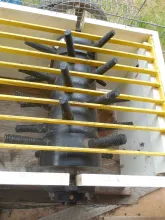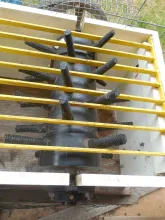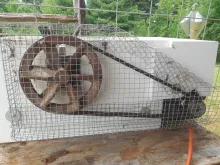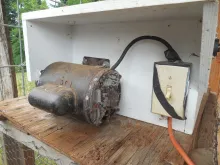Anyone who has plucked chickens by hand knows what a chore it can be. After doing a lot of searching online, I found mostly designs of the "Whiz-bang" model - which uses a drum with rotating bottom and lots of plucker fingers on the sides to process multiple birds at once in a very efficient process. However, the design was also quite a bit more complex, and I wanted something that I could put together out of simple and readily available parts. I found an image of a commercial unit with a table-top design, and reverse engineered it to fit my needs.
I neglected to take a good picture of the whole unit, and will have to update again in a few weeks once we have slaughtered our broilers, and can post a video of the plucker in action. It takes maybe a minute or two to pluck a chicken with it.
Parts List:
5/8" or 3/4" Plywood (free)
2x four-bolt flange bearings (~$30)
1 hp motor (3450 RPM) - this is overkill, but i had it laying around, so I went with it. (free)
7.5" 5/8" bore v-belt pulley - came from the same place as the motor (free)
1.75" 5/8" bore v-belt pulley ($5)
1/2" automotive v-belt - size will depend on your dimensions ($5-10)
Length of 4" ABS pipe (free)
2x 4" ABS caps (~$20)
5/8" all thread for shaft - ($5)
1/2" x 1/8" flat stock for grate - (free)
20-30x Plucker fingers ($20)
Broken extension cord, old light switch, waterproof(ish) junction box - (free)
Misc: hardware cloth, bolts, screws, paint, etc ($5)
My cost: ~$92
Design & Construction:
Basically, this unit consists of a rectangular plywood box, open at top and bottom, with a steel grate that rests on small cleats on the short ends. The grate, shown in Image #3 is the only part which required welding (or brazing would also be fine) but could probably be replaced with thin wooden slats, steel slats that were permanently fixed, or some other system that didn't require metalworking. The grate does not really need to be easily removed, and sometimes if a foot or a wing gets down in one of the channels the fingers can bump the grate loose. If I was doing it again I might try and do this part differently.
Inside the box, and supported on both ends by the four-bolt flange bearings, is the drum that rotates the rubber "plucker fingers." The drum is made of a short section of 4" ABS pipe, with one cap glued on, the other one can be unbolted to disassemble everything. I laid out a pattern of 3, 4, 3, 4 etc, but my guess is that any pattern will work okay. Its not visible in the image, but i actually wound up with something like 28 holes due to my pattern, and having only purchased 25 plucker fingers, i just left a few blank. I don't really notice that they are missing.
Image #2 shows a closeup of how I mounted the removable end cap. I have never actually taken this thing apart, so this step does not seem really necessary. You could probably just glue both ends on once all the fingers were mounted. Make sure that the 5/8" (or whatever size your shaft is) holes are fairly well centered, or the machine will vibrate excessively. The reason I used all-thread for the shaft was so that I could put nuts on the inside surface of the caps, and then tighten down a second nut from the outside, gripping the whole drum and forcing it to rotate. This seems to work just fine, and nothing has loosened up in the 4 or so years that I have used it.
In Image #4 you can see the layout of the pulleys. I stepped my setup down from 1.75" at the motor to 7.5" at the shaft. That gives me something like 800 RPM at the drum, and that seems like a good speed.
A note on safety: A cage around the belt and pulleys is a good idea, even though you stand on the far side of the machine and probably would never get anything caught in there. Farming is dangerous enough, so don't push your luck. Also, you are going to be plucking wet chickens, and hosing this thing off, so pretty please, use a plug with a ground, and only run it on a GFCI circuit.
Belt tension on my plucker was achieved by using the shortest belt I could get over the pulleys with the motor at the same height as the shaft, then letting the motor slide down the outside of the box until the slack was taken up. Mark your bolt holes at that position, drill, and reinstall the motor.
I added the little shelf/cover over the motor after the fact, but it is a nice feature, and would be easier to implement from the start. It keeps feather and gunk off the motor, and also makes a nice handle to pick it up by.
Use:
Using the plucker is pretty self explanatory, although you will have to develop your own technique depending on what you are plucking. We do mostly broiler chickens, but have also used it to do larger birds like turkeys. Basically you plop the scalded bird onto the grate, holding it by the feet, or wing tips, and then flip it around to let the fingers pluck off the feathers. The rubber fingers slap pretty hard, but they are not dangerous, and it is not hard to keep your hands clear of them. Feathers will get thrown off the end farthest from the motor, and pile up inside the machine if it is sitting on a flat surface like a table. If you have a lot of birds to pluck, setting up on sawhorses will let the feathers fall out the bottom. When you are done, a quick rinse with the hose cleans its it up in no time.
That is about all there is to it. This machine has paid for itself many times over, and we are only doing about 40-50 birds a year with it. It is a simple and reliable machine, and has already given us 4 years of solid use with no issues. While it is certainly slower than a Whizbang plucker, for the price, simplicity and compact size, it has proven to be a real asset for small scale poultry growing.






Comments
Have you ever tried to dry
Interesting. I have the exact